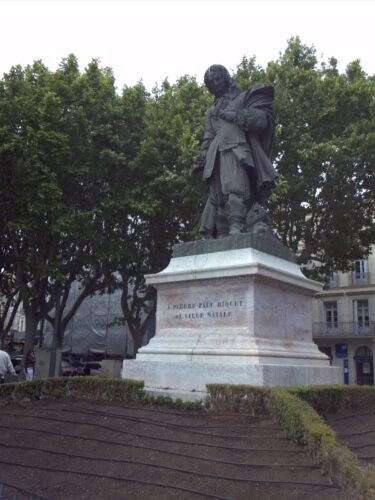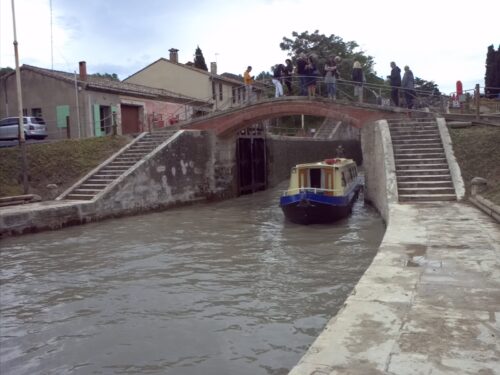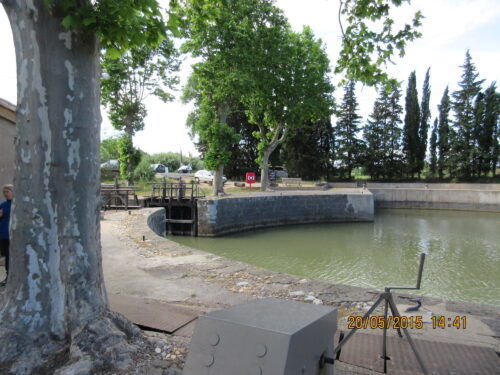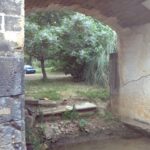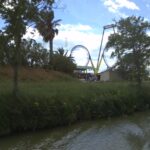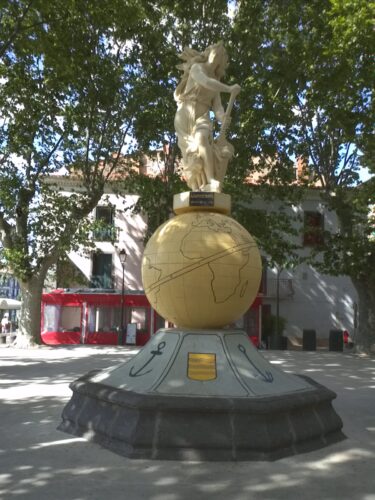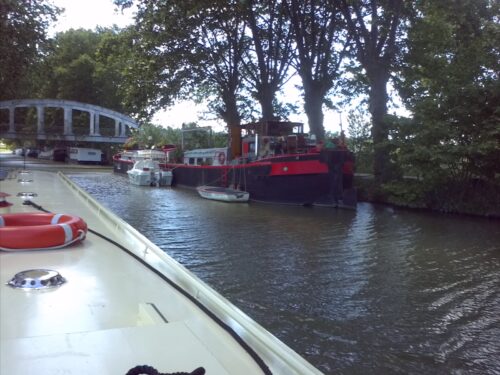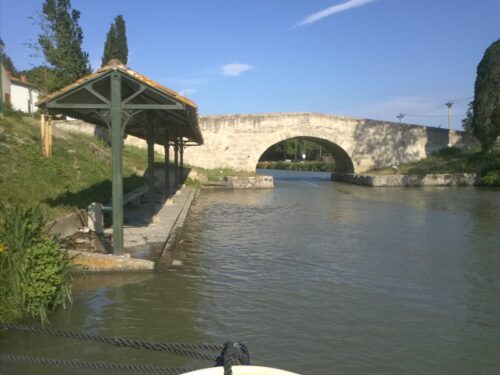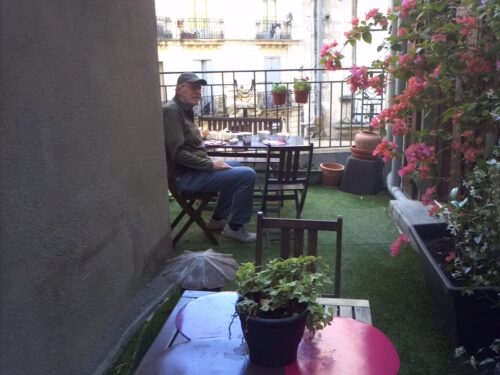Canal du Midi, May 2015
Introduction
- Below Béziers
- Montpellier at Capestang mooring
Our week-long cruise on the Canal du Midi was the filling in a sandwich whose outside consisted of our first visit to Narbonne and a quick return to Montpellier. Our time in those two towns is mentioned at the end of this post.

Hiring a boat
Between 1982 and 2004, we owned a 40-foot narrowboat and cruised the UK canals; since selling our boat, we have sometimes felt we would like to have another go. On previous cycling trips, we had seen the Canal du Midi from the towpath and had the impression that all of the hire boats were white plastic cruisers (aka ‘gin palaces’). But when we discovered that Minervois Cruisers were renting out traditional UK narrow boats, we felt inspired to renew our cruising experiences with a familiar type of boat. The Montpellier at 49 feet is a little bigger than ours was, but we were pleased to have the extra space – you need to be very tidy in a 2-berth boat.
Our choice proved a good one, the low-slung steel hull of Montpellier gave her total stability even in the heavy winds we experienced on several days and the tiller steering positioned on the rear deck – as found on virtually all UK canal boats – gave us more precise control than wheel steering. The downside was that you are always outside and exposed to the elements while travelling – we were used to that but the exposure to the sun might have been a problem had there been more of it!
- Montpellier at Béziers
- Fonserranes top lock
- Aqueduct over Orb at Béziers
Several possible round-trip itineraries are available from the Minervois base at Le Somail: we had to decide between a western one to Carcassonne, a southern one to Narbonne or the one we took: eastbound to Agde and back.
[aside type=”note” status=”open”]
A note on the Canal du Midi
The Canal du Midi was built in 15 years from 1666 to 1681, about one hundred years before the Bridgewater Canal – the first in the UK.
Apparently there had long been felt a need to link the Atlantic and the Mediterranean so as to save traders from having to take the long route round via southern Spain and this came to a head during the reign of Louis XIV. The general idea was to build a canal from the Mediterranean coast somewhere near Narbonne or Sète to Toulouse where the link could be completed along the River Garonne. But the main perceived difficulty was to provide sufficient water supply at the summit at the watershed of Narouze, where there were no nearby rivers.
The king’s minister Colbert commissioned Pierre-Paul Riquet who knew the area to carry out the works (the photo on the right is of a monument to Riquet in Béziers). Riquet designed a reservoir and complex set of feeder channels and to collect and distribute water from little streams in the Black Mountains down to a big basin at Narouze.
It was suggested that the eastern end of the Canal du Midi should follow the river Aude through Carcassonne finally reaching the Mediterranean near Narbonne. But Riquet pointed out that the Aude was not reliably navigable and that it is better to follow its course to make use of the water but to be far enough away to be affected by flooding and consequent silting up in the canal.
We recommend “From Sea to Sea” by L.T.C Rolt (published by Euromapping) for a full account of the challenges faced by Riquet in constructing the Canal du Midi and how he overcame them. We will mention some examples that we saw during our cruise from Le Somail (north of Narbonne) to Agde.
[/aside]
Monday 18th May Le Somail – Capestang by boat
A 20 minute taxi ride from Narbonne brought us to the Minervois base in the village of Le Somail. There Emily of Minervois Cruisers greeted us on a beautiful sunny morning and we spent a pleasant hour chatting with her and going over the features of our boat before setting off. We had decided to spend our week cruising eastward to Agde where the canal joins the river Hérault. Soon after setting off we crossed the aqueduct over the River Cesse. West of this point the canal follows the route of the River Aude, but here it takes a more northerly route towards Béziers (Riquet’s home town) rather than heading towards Narbonne, whose inhabitants wanted the canal to link up with the Canal de la Robine that would link Narbonne to the River Aude. We soon passed the entry to the Canal de la Jonction that was eventually built in 1856 to link the Canal du Midi with Canal de la Robine.
We made our first stop for a picnic before the village of Argeliers, discovering that we needed to refine the technique in which George brings the boat to a halt just by a little jetty where Jean jumps off with the mooring rope.
- First day out on Montpellier
- Capestang mooring
- View down from canal to Capestang
We soon reached Capestang and moored up for the night by a grassy bank. The village of Capestang is on the south side and well below the canal which is built on a contour half way up a hillside. This pound, le Grand Bief, in French, is the longest at 54 kilometres between the Argens lock west of Le Somail and the top of the Fonsérranes Locks at Béziers.
- Collegiale St Etienne
- Capestang
- Capestang drink
We walked into Capestang and sat in the square with a drink before exploring the village including the immense gothic Collégiale St-Etienne. Back to the boat for a simple evening meal of tinned saucissons and lentils followed by apple, banana and fromage blanc.
Tuesday 19th May Capestang – Béziers by boat
It started cold, with light rain most of the day, so we wore our macs and waterproof trousers while steering the boat. We passed Paulhes village sited well below the level of the canal, where there had been a serious flood in 1744 when 300m of the canal bank was breached.
Next we passed through the Malpas tunnel, which we will illustrate on the return journey when the weather was more suitable for taking photos. This tunnel was the first navigation tunnel in the world and a truly bold choice by Riquet because the soil of Malpas hill was apparently very weak. Against advice, Riquet built it clandestinely in a week. It is 165m long and 8m high, the roof being held up by stone arches.
- Paulhes village
- Condemned tree
Fonsérranes locks
Soon after the tunnel, we reached the head of the famous Fonsérranes flight of locks that was designed by Riquet to take boats down the 25m drop to the River Orb below. They are often referred to as the “nine locks” but in fact, there are nine gates with eight lock chambers.
Riquet’s idea was that the canal should join the Orb for a few hundred metres and then branch off on the other side towards Agde. But the Orb is often flooded and at other times rather dry, so this didn’t work very well. So in 1854, a grand aqueduct was built to carry the canal over the Orb; to get the levels right, this was accessed from the sixth lock down the flight and the seventh (bottom) lock was closed.
The sluices are electric and are operated by the lock keepers who also open the gates when the water level is ready. But with only two people in the boat, there’s quiet a lot to do at each lock in the staircase. George took the boat into the lock while Jean stood on the side waiting for George to throw the rope at the right moment; on receiving the rope, she passed it round a buoy and dropped the end back to George who held on, gradually easing the rope out as the water level dropped. Some of the lock keepers told us that we had to use two ropes whereas we had usually managed with a single central rope in the UK canals.
- Fonserranes top lock
- Fonserranes top lock
- Fonserranes 2nd lock
A little before the gates are ready to open, Jean walked down the steps to the next lock and waited for George to appear with the boat.
- Fonserranes looking down flight
- Fonserranes looking up
- Fonserranes – Montpelier emerges
The lock chambers are oval in plan with a very wide midpoint to accommodate the wide trading vessels used in 17th century. The walls were constructed from horizontal arches and the combined shape would be good for resisting ground pressure. But the curved walls must be odd with a very long narrow boat, although our boat Montpellier seemed to fit in alright.
- Fonserranes
- Fonserranes
- Fonserranes – circular pounds
Béziers
We still had to negotiate one more very deep lock (described somewhere as ‘cavernous’). Then we were in Béziers Port where the very friendly skipper of a Eurovoyages hotel boat carrying a group of Americans on a deluxe holiday helped us to moor and let us fill the water tank using his hose. We then went into town by a fairly direct, but very nasty route through a tunnel under the railway and alongside some heavily-trafficed roads. Fortunately this took us into a park and on to the Plateau de Poètes and eventually we reached the cathedral and were pleased to see the magnificent view over the plain below that we had remembered from our previous visit to Beziers in 2000.
We wandered around narrow streets in the semi-deserted town before eating good meal in a North-African restaurant – lemon chicken tagine and couscous. We found a very good route for the walk back to the port – down the hill to the River Orb with a magnificent sunset view through the arches of several bridges; then turn left on the towpath to reach the port.
- View from Cathedral
- Béziers cathedral
- Béziers
Wednesday 20th May Béziers – Agde by boat
To leave Béziers Port we had to descend through another deep lock (we noted that there’s no place to moor below the lock, so mooring in the port, as we had fortunately done, is the only option). The banks are covered with lush vegetation but this doesn’t completely mask the presence of large roads nearby.
We stopped to buy bread at the lock at the village of Villeneuve-les-Béziers and identified it as a nice place to spend a night on our way back. On arrival at Portiragne lock, we stopped for lunch while the lock keepers had their lunch hour.
- Portiragne lock
- Villeneuve-les-Béziers
- below Béziers
Ouvrages de Libron
The canal intersects the River Libron soon after Potiragne and they are nearly at the same level – close to sea level so neither could be carried over the other on an acqueduct. This presented Pierre Ricquet with a knotty engineering problem since the Libron is normally a very shallow river, no use for navigation. The bed of the river is a little lower than the canal but not low enough to take the canal over the top when the river is in flood. We had read about Riquet’s ingenious solution in which at times of low flows, the river Libron runs in a culvert under the canal and at times of flood the canal is blocked by a barge-like structure with channels that carry the river flows over the canal.
At this passing, we were completely mystified by the works we passed though! We read about it before our return and will attempt to explain it when we get to that day in our log. We meekly entered two consecutive series of wide stone arches with strange caverns on each side through which we could spy little country scenes. As we left the magnificent contraption, we looked back with wonder.
- Ouvrages de Libron
- Ouvrages de Libron
- Ouvrages de Libron
- Ouvrages de Libron
- Fairground
- Fairground
On leaving the contraption, we passed by an amusement park and soon arrived in Agde: we have strict instructions not to enter the round lock that marks the end of this section of canal. Since we would be starting our return voyage tomorrow, we circulated the port looking for moorings before tying up in a tight space a few hundred metres back along the canal with a clamber up the bank.
Agde
The River Hérault at Agde is a large and powerful river, not far from its mouth, but to ensure there will always be a sufficient level of water, a weir was constructed below the canal crossing.
The round lock was built so that boats have a choice of either going straight across the lock chamber to continue via a short section of the River Hérault to the eastbound canal which continues in a salt-water channel to Séte; or turning to the right to take the Hérault branch to join the Hérault below the weir.
- Agde port
- Agde round lock
- Old print of Agde round lock
We were kicked out of the lock precinct before we managed to take many photos of the round lock, so have relied on an old print! We then followed the path beside the Hérault branch and crossed the bridge into the old town of Agde. Our first impression was of the buildings made of black basalt – a cinder coloured volcanic rock. In particular, he big blocky cathedral loomed ahead of us.
- Agde cathedral
- Agde cathedral interior
- Agde cathedral interior
We had heard that Agde had been founded as a Greek colony and that the beautiful 400 BC bronze Ephebe of Agde had been recovered from the river bank. We were looking forward to seeing it in the museum of archeology but unfortunately it was closed. But we enjoyed wandering round the colourful narrow streets, eventually emerging on the river bank downstream from the bridge. The riverside walk was one of the best we have seen: paved in basalt, it had a quiet atmosphere combined with a few bars and waterside restaurants. It was a very pleasant contrast with the waterside at Gruissans or Sète. Eventually we returned to the boat for dinner.
- Agde
- Agde metalwork
- Agde statue
- Agde another statue
- Agde courtyard
- Agde cat
Thursday 21st May Agde – Villeneuve by boat
We both woke early, thinking it was raining… actually just a rope was tapping. We decided not to walk back into Agde to see the museum, but we would like to see the statue of Ephebe one day. It was a very windy day, but fine and sunny. Our first stop was to try to suss out the contraption.
Ouvrages de Libron again
- Ouvrages de Libron from above
- Ouvrages de Libron from above
- Ouvrages de Libron from above
Our first photo shows the central basin with a series of stone arches beyond it – there is another series behind the basin. Above the arches is winding gear that can pull sluice sections across the channel – second and third photos. If the Libron is in flood, the sections of sluice are pulled across the canal e.g. on the Agde side to allow the river to flow across the top. Meanwhile, an eastbound boat enters via the first series of arches and then moors in the central basin. After that, the sluices are deployed behind the boat and the ones on the Agde side withdrawn to let the boat through.
From here the canal passes by what appears to be a nature reserve on the south side with a greater variety of trees and plants to add to the canalside plane trees before arriving at a bridge leading to the Mediterranean holiday resort of Port Casafieres.
Port Casafieres and Portiragne Plage
We had been longing for a dip the the Mediterranean and at Port Casafieres, we were only about 2km away from the coast. It was very windy, so we realised that the idea of a swim was wishful thinking but after mooring we walked down to the beach, where we dipped our toes in. It was a sandy beach but not many people were about to experience the sand flying in the wind.
We bought lunch in a bakery and then found WiFi in a cafe to book via AirBnB a place to spend the last night of our holiday in Montpellier.
- Portiragnes Plage
- Villeneuve-les-Béziers
- Villeneuve-les-Béziers
- Villeneuve-les-Béziers
- Villeneuve-les-Béziers
- Villeneuve-les-Béziers
We cruised on to Villeneuve-les-Beziers, finding masses of mooring space and convenient tree supports to tie up to. It is a small town comprising many interesting narrow streets, mostly with 20 mph limits and signs showing that pedestrians and cycles have priority. In the centre we found the Eglise St Etienne – a romanesque church that had been partially destroyed by fire and reconstructed. A big tower is all that remains of the chateau – also a victim of fire. The big main square houses an immense Town hall and a police station with a good mural as well as a retired “les Halles”.
Our supper was composed of some interesting dishes from the charcuterie (endives with ham, courgette soufflé and tabouleh). Also delicious pear tarts from the patissier.
Friday 21st May Villeneuve – Béziers – Colombiers by boat
A long day with lots of locks as we had to go back up the Fonsérranes flight as well a some other locks. But it was a very sunny day (the wind persisted). Before leaving Villeneuve, we went to the water point whose ‘tap’ was a operated by a jeton from the nearby charcuterie, so we had to take all the water offered, no more, no less through a very kinky hose. We took photos of some of the interesting boats we saw on the way to Béziers.
- Early start from Agde
- Colourful barge
- Young family of ducks
- Beautiful Dutch barge
- Beautiful Dutch barge
- Eco boat?
- Eco boat detail
- Eco boat detail
- The Swan seen next morning
We went straight through the Villeneuve lock and another at Portiragne, then after 4km the two very deep locks at Béziers – with vertical poles inset in its walls to pass the rope through and hold the boat steady as the water rises – no need to climb up the ladder! Then we crossed the magnificent high aqueduct over the River Orb from which were marvellous views of Béziers.
- Béziers from below
- Aqueduct over Orb at Béziers
- Yellow iris
We had a long wait at the bottom of the Fonsérranes flight of locks as the up and down movements are handled in batches and the upwards trips was not due to start until 4pm. We had another look at the inclined plane that was built in 1983 (we had previously seen it on one of our bike trips in the area) for boats too large for the locks. Boats would be hauled up it a water-filled steel trough, but the project was a failure and was soon abandoned.
- View of Béziers from below
- Inclined plane – failed project
- Béziers wait
Eventually we got the green light to enter the bottom lock! The trip up the locks was very dramatic: each time we entered a lock chamber, the one above was also open and water was pouring down into ours! We were through the entire flight of seven locks in about 30 minutes.
- Fonserranes staircase locks
- mounting Fonserranes staircase locks
- Fonserranes – some used boat hooks
- mounting Fonserranes staircase 2
- Mounting Fonserranes staircase 3
- Mounting Fonserranes staircase 4
We then had a restful cruise to Colombiers where we moored next to the Lavoir by the bridge – lots of young duck families were about. This had been our longest day of cruising and we were pleased to have covered a good distance because it enabled us to plan a leisurely schedule for the remaining two days of our holiday.
Not much was going on in Colombiers village but there is a busy cruise boat port with many restaurants. We had very good food at a creperie where we chatted with a Dutch cyclist who was riding long distance from Barcelona to The Hague.
Saturday 22nd May Colombiers – Argeliers by boat
Malpas Tunnel
In the morning we walked about a mile along the towpath to have a good look at the Malpas tunnel, first looking at one end, then from the towpath inside the tunnel. We also found a good view down from above.
- Malpas tunnel
- Malpas tunnel 2
- Malpas tunnel 3
- Above Malpas tunnel
- Malpas tunnel 4
Oppidum of Enserune and Etang de Montady
Another 3/4 mile walk on a steep path up the hill above the tunnel brought us to the Oppidum of Enserune: the hill top site of a Gaulish town that was settled from 600 BC to 100 AD. From below we saw a lovely hill top site surrounded by tall cypresses and rugged pine trees. This naturally protected site was apparently typical for an Iron Age Gaulish settlement. Inside the site, the first impression is of the beautiful herbs and flowering plants flourishing amongst the ruins.
- Oppidum d’Ensérune
- Oppidum d’Ensérune
- Oppidum d’Ensérune
- Oppidum d’Ensérune
- Oppidum d’Ensérune
- Oppidum d’Ensérune
The oppidum provides an excellent viewing point over the Etang de Montady:
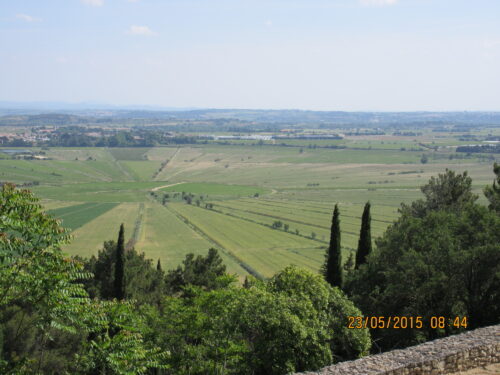
Etang de Montady
The Etang de Montady was constructed by monks during the 13th century. The wide marshy area was drained by means of radial ditches dropping down to a circular pond in the centre. The collected water is then drained via an underground culvert through the Malpas hill at a lower level than the canal tunnel. The scheme is on the land of several farmers who own segments of the circle and they have successfully maintained the channels down the centuries – a bit of medieval engineering that is as effective today as 700 years ago. The diagram on the right indicates that a tunnel to carry the railway was added at a later date. It runs through the hill at a level between the drainage culvert and the canal tunnel!
The Gaulish Village
The hilltop would have had steep sides, but these must have been terraced to provide space for houses or crop growing. A small town was created with stone houses and streets. We walked along the north side, passing a storage area with large earthenware pots buried in the ground and a cistern in which rain water was collected. The houses must have varied in size, for example we saw the foundations of a large house with a roman column next to it amongst the remnants of many to smaller houses. On the south side of the site are remains of other houses on a terrace with magnificent views over the valley. The Gaulish cemetery is at the far end of the hilltop, well away from the houses.
- Village Gaulois d’Ensérune
- Gaulish village – storage area (buried pots)
- Gaulish Village – big house with column
- Gaulish Village – big house with column
- Gaulish village- steps to higher level
- Gaulish Village -housing area
- Gaulish Village– artisan quarter
- Gaulish Village – north side grain stores
- Gaulish Village – south side stone houses
 The site was excavated during the first half of the 20th century and the artefacts are displayed in a museum on site. Most of these finds come from the cemetery area – people must have been buried with some of their possessions. From the large collection of black varnished Grecian pots decorated with red and black figures, it is clear that there must have been trade with the other nearby Greek settlements (e.g. Agde and Marseilles). As we didn’t take photos, we have inserted an image from the museum’s website. There are also red clay pots with relief decorations and plain ones in Roman style for storing wine, oil or water. And a big collection of domestic and farming tools, and weapons. The coins are described as Iberic – Spanish. Samples of writing are in a script containing some letters similar to those in the Greek alphabet.
The site was excavated during the first half of the 20th century and the artefacts are displayed in a museum on site. Most of these finds come from the cemetery area – people must have been buried with some of their possessions. From the large collection of black varnished Grecian pots decorated with red and black figures, it is clear that there must have been trade with the other nearby Greek settlements (e.g. Agde and Marseilles). As we didn’t take photos, we have inserted an image from the museum’s website. There are also red clay pots with relief decorations and plain ones in Roman style for storing wine, oil or water. And a big collection of domestic and farming tools, and weapons. The coins are described as Iberic – Spanish. Samples of writing are in a script containing some letters similar to those in the Greek alphabet.
Eventually we left the Gaulish Village and walked down the hill to the boat where we had lunch. After the sunny morning, the clouds started to build up and the strong wind returned. We went through the tunnel and two very meandering stretches if canal, observing places for letting off excess water on the downhill side of the canal. We passed Capestang, trying to avoid a crew of mad people in a big metal boat called Escargot who were repeatedly doing 360 degree turns.
The moorings at Argeliers just above the bridge have convenient posts for mooring and a very pleasant atmosphere. A quick walk into the village and then a meal on board (crudités, pasta, fruit compote and fromage blanc).
Sunday 23rd May Argeliers – Le Somail by boat
We spent the morning in Argeliers, a lovely village approached through a vineyard. In the centre we found an exhibition of photos on the walls of several buildings, portraying a viticulteurs strike in 1907 led by local hero Marcelin Albert. Their problem was the combination of people making fake and adulterated wines and high taxes had left them in poverty and starvation. There were demos in most of the towns in the local wine growing area with huge numbers attending. The cavalry were sent in to suppress them, some died and many were injured. In the 1930s the viticulteurs set up a cooperative and got fairer prices for their products.
- Argeliers
- Argeliers church
- Argeliers vineyard
- Argeliers figure
- Argeliers walkway
- Argeliers house
A short cruise down to the junction with canal de la Jonction where we stopped for a quick look. There’s a lock and then a canal that links to the Robine along which we had walked in Narbonne. Then we walked a little to have a look at the aqueduct over the River Cesse.
- on the way to Canal de la Jonction
- Aqueduct over Cesse
- Le Somail
Arriving back at le Somail we moored doubled up with another Minervois boat called Olonzac.This village is packed with visitors sitting around in the bars, getting off bikes and into motor caravans, We looked at the Ancienne Librairie – a bookshop in a very big shed of rather expensive second-hand books. It has been there for 34 years, before that it was a wine storage warehouse.
We had a very good meal at L’ô a la bouche – tasty and imaginative imaginative dishes. Cruditees or gaspacho for starters then daurade with vegetables and polenta, Tarte Tatin to finish.
The next morning we had to hand the boat back. Emily’s partner Tony arrived and pumped 50 litres fuel into the tank (75€). We then took a local taxi to Narbonne station and a train to Montpellier where we arrived at noon.
How we got there and back – Narbonne and Montpellier
We used Eurostar between London and Paris and TGV between Gare de Lyon and Narbonne/Montpellier. On the way out, we left St Pancras at 12:25 and arrived in Narbonne at 10:40 pm. On return we took the 13:30 train from Montpellier and arrived at St Pancras at 20:25.
Friday 15th – Sunday 17th May Narbonne
We stayed in a studio in a fine building with a big green entrance door in Cours de la Republique, right in front of the Canal de la Robine and a couple of hundred metres from the centre of the medieval city – Place de l’Hotel de Ville. The studio was set well back – a big room, real bed, good sitting area, dining table, well-equipped kitchen and bathroom.
At breakfast time and during the day, lots of people about but very quiet in the evenings – we ate in a pizza place one evening. Then we discovered Les Halles a stupendous market just across the canal with really good ready made dishes as well as enormous arrays of fruit, veg, fish and meat. Thereafter we bought the ingredients and organised most of our meals at home.
Main square: old Roman Road Via Domitia passes through at a lower level.
Palais Archeveques: three square towers with Town Hall between two of them (Viollet le Duc). Big stone mediaeval spiral staircase with horrid modern sculpture snaking through and poking out. Art Museum portraits, still lives, good rooms, decorated ceilings. Top floor installed to look like Cordoba mosque – life in muslim countries.
Cathedral St Just and St Pasteur: really only half a cathedral – very tall, gothic, stained glass with patterns, good gothic cloisters.
Pont des Marchands: lined with shops, rather like Burlington Arcade.
Lapidary Museum: big stones from old buildings piled up all walls – intriguing. Why are the stones all the same size?
St Paul Cathedral: big early gothic – much better than the “real” cathedral.
Concert Quintettes de Trompettes in Salle des Synodes du Palais des Archevêques. A variety of sorts of trumpets played arrangements of classic and baroque pieces of music.
- Narbonne Hotel de Ville
- Narbonne: staircase in Palais de Archeveques to Art Museum
- Narbonne museum
Narbonne – Gruissan by bike
Hired bikes from VTT – Hugo Blanquier – friendly people, good heavy bikes with front and back derailleurs, disk brakes. Rode canal towpath to Ecluse de Mandirac and then on minor road with very strong wind behind us, beside Etang de Gruissan, view of tower of old chateau. Lunch outside a bakers shop. Went round harbour… lined with modern apartment buildings, too many sailing boats and boring people. Ride back very tough against the wind.
- Cycle route signs
- On bike ride to Gruissan
- Gruissan
Monday 24th – Tuesday 25th May Montpelier
Stayed at IDA B & B in centre of pedestrian city. Good room and shower, nice terrace for breakfast. Eventually met host Sybil in the morning at breakfast.
- Montpellier Street
- Montpellier
- Montpellier B and B
What did we do? Wandered the streets, sat in Champs du Mars, meal out. Musée Fabre – the main art gallery with a big collection of mostly unknown Dutch and Flemish, but excellent 19th and 20th century works. Room of Courbets.






